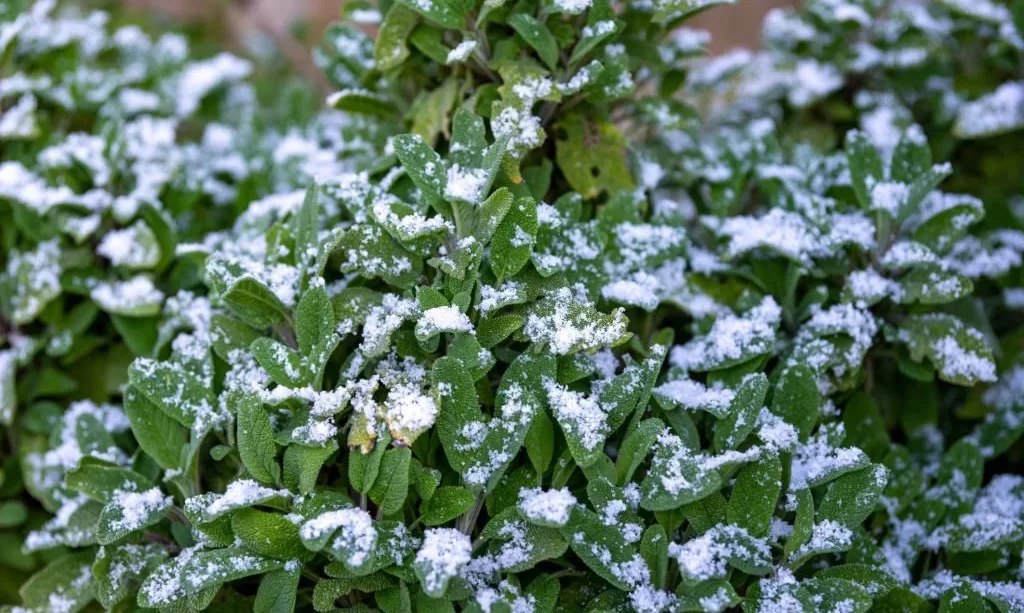Sage, with its distinctive fragrance and earthy flavor, is a culinary herb that has long been cherished in kitchens around the world. Whether you’re preparing a savory stuffing for Thanksgiving or infusing olive oil for a gourmet pasta dish, the addition of fresh sage leaves can elevate your culinary creations to new heights. However, one common challenge that herb enthusiasts face is how to keep sage fresh and flavorful for extended periods. In this article, we will delve into the world of sage and explore a simple yet effective solution: freezing sage leaves. Can you freeze sage to preserve its essence and enjoy its delightful flavor year-round? Let’s embark on this flavorful journey and find the answers.
- Selected and stored fresh
- Sourced with high quality standards
- Recommended to wash before consuming
- Delicious on their own as a healthy snack or as part of a recipe
Sage and Its Uses
To truly appreciate the practice of freezing sage, it’s essential to understand the herb itself and its culinary significance. Sage is a herb known for its aromatic leaves, which boast a warm and slightly peppery flavor with hints of eucalyptus and citrus. Its versatility in the kitchen is unmatched, making it a staple ingredient in countless recipes. Sage pairs beautifully with poultry, pork, pasta, and even in vegetarian dishes, adding depth and complexity to the flavor profile.
However, the challenge with sage lies in its perishable nature. Fresh sage is known for its robust aroma and taste, but it tends to wilt and lose its vibrancy quickly, especially if not used immediately. This dilemma leads us to explore the option of freezing sage, a practice that can help preserve its delightful flavor, making it a valuable asset in your culinary repertoire. As we delve deeper into this topic, you’ll discover the steps to freeze sage effectively, ensuring that its essence remains intact for when your recipes call for a dash of culinary magic.
Preparing Sage for Freezing
Before you embark on the journey of freezing sage, proper preparation is essential. Here’s how to get started:
- Harvesting Sage Leaves: If you have a sage plant in your garden, harvest fresh sage leaves. Alternatively, you can purchase bundles of sage from your local store. Choose leaves that are vibrant, free from blemishes, and at their peak of flavor.
- Cleaning Sage Leaves: Gently clean the sage leaves by rinsing them under cold running water. This step removes any dirt, dust, or debris that may be clinging to the leaves.
- Drying Sage Leaves: Pat the cleaned sage leaves dry with a clean kitchen towel or paper towels. It’s crucial that the leaves are completely dry before freezing, as any moisture can lead to freezer burn.
- Optional: Drying Sage Leaves: If you don’t plan to use all your sage immediately, consider drying some leaves. You can do this by hanging bundles of sage in a dry, airy place until they become crispy. Dried sage can be stored in airtight containers for extended periods.
Freezing Sage Leaves
Freezing sage leaves is a simple process that helps preserve their flavor and aroma. Here’s how to do it:
- Individual Freezing: Lay the dry sage leaves individually on a baking sheet, ensuring they don’t touch each other. This prevents them from sticking together during freezing.
- Quick Freeze: Place the baking sheet in the freezer and allow the sage leaves to quick freeze for a few hours or until they become firm. Quick freezing helps retain the herb’s quality.
- Alternative: Sage Cubes: If you prefer a different approach, consider making sage cubes. Place chopped sage leaves in ice cube trays, cover them with water or olive oil, and freeze. This method provides convenient portions for recipes.
Storing Frozen Sage
Once your sage leaves are frozen, it’s important to store them properly to maintain their freshness:
- Airtight Containers: Transfer the quick-frozen sage leaves into airtight containers or freezer bags. Removing excess air from the packaging helps prevent freezer burn.
- Labeling: Don’t forget to label the containers with the date of freezing. This ensures you can use the sage leaves in a timely manner and keep track of their freshness.
- Ideal Freezer Temperature: Maintain your freezer at the ideal temperature, typically at or below 0°F (-18°C), to ensure your sage remains in excellent condition.
With your sage leaves properly prepared, frozen, and stored, you’re well on your way to having a convenient supply of this aromatic herb at your fingertips for your culinary adventures. In the next sections, we’ll explore how to use frozen sage and the advantages of this preservation method.
Using Frozen Sage
Once you’ve successfully frozen your sage leaves, you might be wondering how to incorporate them into your culinary creations. Here’s how to use frozen sage effectively:
- No Need to Thaw: One of the advantages of freezing sage is that you can use it directly from the freezer. There’s no need to thaw the leaves. Simply take them out and add them to your recipes.
- Cooking with Sage: Frozen sage works wonderfully in cooked dishes where the leaves can infuse their flavor into the food. Add them to soups, stews, sauces, and roasts for a delightful herbal touch.
- Chopping or Crushing: If a recipe calls for finely chopped or crushed sage, you can do so while the leaves are still frozen. This can be more convenient than working with fresh sage, which can be delicate.
- Flavor Enhancement: Frozen sage retains much of its flavor, so you can enjoy the same aromatic and earthy notes in your dishes as you would with fresh sage.
Benefits of Freezing Sage
Freezing sage offers several benefits for home cooks and gardeners alike:
- Extended Shelf Life: Freezing sage allows you to extend its shelf life significantly. No more worrying about wilted or wasted sage.
- Year-Round Availability: With frozen sage, you can enjoy the herb’s flavor year-round, even when it’s out of season.
- Convenience: Having frozen sage readily available in your freezer makes meal preparation more convenient. It’s a time-saving solution for busy cooks.
- Reduced Food Waste: By freezing sage, you reduce food waste, as you can use it at your own pace without fear of it spoiling.
Conclusion
In conclusion, freezing sage is a practical and effective way to preserve this aromatic herb’s flavor and aroma for future culinary adventures. Understanding how to prepare, freeze, and use sage ensures that you can enjoy its delightful essence year-round, enhancing your dishes with a touch of culinary magic.
So, whether you’re harvesting sage from your garden, purchasing it in bundles, or simply want to make the most of this versatile herb, consider freezing sage as a culinary resource that’s always at your fingertips. It’s a flavorful journey that connects your kitchen with the bounties of your garden and allows you to savor the essence of sage in every meal.



![YESOON [30 Pack Reusable Freezer Food Storage Containers with Lids [26oz-40oz-70oz] Plastic Meal Prep Container Sets Bento Box BPA Free Freezer & Microwaveable & Dishwasher Safe](https://m.media-amazon.com/images/I/41MVKSR5kKL._SL160_.jpg)

